Suppose you have switched from the old Google Analytics (Universal Analytics) version to the new version (GA4). In that case, you may have already seen some new metrics within your dashboard that were not there previously. This article will discuss one of the most crucial new metrics within GA4: engagement rate.
We’ll explain engagement rate, how it’s calculated, and why it’s important, and we’ll equip you with practical tips to improve it. We’ll also show you where to find the engagement rate within GA4 using screenshots as a guide, and by the end of this article, you should feel capable of improving the engagement rate and user experience on your site.
What is the Engagement Rate Metric in GA4?
The engagement rate metric found within GA4 is a simple way to tell you the percentage of engaged sessions on your website. It gives you information on the split of people interacting with your site instead of visiting a page and then clicking off without interacting.

The engagement rate metric within GA4 replaces the bounce rate metric you found within your Universal Analytics dashboard. But it’s important to remember that engagement rate is the opposite of bounce rate. Bounce rate metrics tell you the percentage of people leaving your site without interacting.
How is Engagement Rate Calculated in GA4?
The equation used to calculate your overall engagement rate for your site or for a single page is very simple. It’s calculated as the total number of engaged sessions divided by the total number of sessions multiplied by one hundred, as you can see in the formula below:
Number of Engaged Sessions / Total Number of Sessions * 100 = Engagement Rate.
Let’s say, for example, that one of your pages sees 13,500 engaged sessions and that the total number of sessions on that page during your chosen period was 26,740. Using the above engagement rate calculation, we can determine that your engagement rate is 50.5%.
Luckily, you don’t need to do any math yourself here, as GA4 notes your engagement rate down for you:
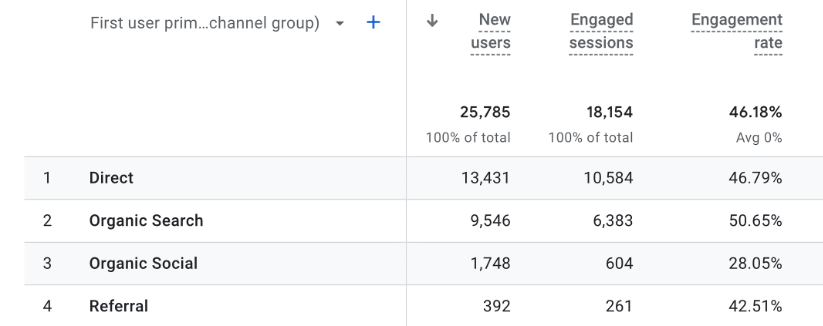
What is a ‘Good’ Engagement Rate?
The most important thing to remember here is that there is no ‘perfect’ engagement rate you need to aim for-except 100%, of course!
Each website will have a different engagement rate, primarily determined by your industry, as well as other factors like your site speed and the usefulness of your content.
So, it is hard to specify a good engagement rate, but you can take industry averages. Portent ran a great study on website engagement rates and found some industry benchmarks you can aim for.
- Entertainment and Media = 51%
- Finance and Mortgage = 69%
- Home and Security = 65%
- Non-Profit Organizations = 66%
- Retail and Consumer Goods = 66%
- Technology and Software = 62%
- Telecommunications and Internet = 74%
- Travel and Hospitality = 71%

Why is Measuring Engagement Rate Important?
Measuring your engagement rate is vital for various reasons. Below, we’ll explain exactly what those reasons are to convince you to use GA4 more regularly, especially to measure the engagement rate of your content.
Helps Show Content Performance
Engagement rate is vital in showing how well your content performs. If users are not engaging with your content, this may indicate that you can improve it and increase overall engagement by implementing a content refresh.
A lower engagement rate might be better. This will depend on the goals of your content, but if you have content out there that has been published simply for brand awareness and is helpful to the user, then the engagement rate may be low. However, in most cases (especially as an engagement can be as simple as a page scroll), a lower engagement rate means something needs improvement.
Identifies Opportunities for Improvement
Actively monitoring your engagement rate can also show you places where your content needs to be improved.
You can do this by benchmarking your engagement rate for different content types. Build-out groups of your content, and ensure they are put into different categories. For example, you can have a group of blog posts, a group of product pages, and a group of feature pages. Then, take an average engagement rate for each of these groups over a set period. You can then use these averages to highlight underperforming content and create plans to improve it.
For example, if you work out that the average engagement rate for a specific blog post type (let’s say it’s listicle content for the sake of the example) is around 55%, and then you notice that one specific listicle on your website has an engagement rate of 30%, then this should tell you that you need to do some analysis to work out why this is lower than average, and then work to improve it.
Measure How ‘Satisfied’ Users Are
In a similar way that your engagement rate can show you how your content is performing, it can also show you how satisfied your users are with your content.
Simple logic tells us that if users are not happy with the content that our website is showing, they are much less likely to interact with our content. If unsatisfied with the content shown when they click on our page, they may bounce and click back to the SERPs to find a more helpful result.
If you can find ways to improve customer retention/satisfaction with your content, you can improve your engagement rate. Luckily, the next section of this article gives you some great tips on improving your website’s engagement rates!
Helps Improve Conversion Rates
If users actively engage with the content you publish, especially if they engage with your content regularly, they are much more likely to convert. A conversion can look different depending on your business and the goals of your content. In some cases, it might be a purchase. In other cases, it could be clicking a link to download a PDF.
If you have well-placed CTAs (Call To Actions) embedded within the content you publish that make sense and are relevant to that topic, you may get users clicking on these CTAs and heading further down the conversion funnel. These CTA link clicks will also count as an engagement within GA4, helping your engagement rate.
An excellent SEO test you can run is to find a blog post on your website without a CTA within the content and place some CTAs throughout the article. Don’t go too heavy on the links; place them well in places that make sense. You may just find that your engagement rate goes up if people click on these CTAs.
How to Improve Engagement Rate
In this next section of the article, we will explore different ways to improve your content’s engagement rate. Some of these tips require little to no effort, whereas others require more effort. However, they will all work the same way to keep users on your site longer and engage with your content more.
Ensure You’re Producing High-Quality Content
One of the best things you can do to improve your engagement rate is to ensure you produce high-quality content on your website.
We have said this before, but the better the content is, generally, the better the engagement rate your content is likely to have!
When writing blog posts, ensure that the topic is relevant to your business, ensure that the content has been well-researched beforehand, and make sure that your goal with every piece of content is to write one of the best pieces on the web when it comes to that topic. We know, of course, that is not possible 100% of the time, but keep ensuring your business publishes high-quality content that is unique and relevant to your business and that you will not go far wrong.
The goal of your content should always be to fulfill search intent. Once that job has been handled, your next goal should be to use the content to move users further along the purchase funnel. If you do this, your engagement rate will increase as more and more people start moving along the funnel following reading your content.
Improve Your Website Design
Improving your website design will help users feel better about using it. This is true whether you’re simply completing a small website update, refreshing the design to make it appear more modern, or doing more work in the background and potentially changing the CMS that your website uses.
Whatever the reason for improving your website design, one of the benefits is generally an increase in engagement rate.
We know from experience what happens when we speed up a website’s page speed, improve its user-friendliness, and make it more visually appealing… More users stick around for our content, and they engage more.
Encourage Interaction with Your Users
When writing content for your website, you should actively consider ‘asking’ users to engage with it. Why do we see CTAs embedded within blog post content or snippets at the end of video content asking users to subscribe? It’s all to encourage users to engage with the content we are putting out.
Not only that, but we can also encourage users to head further along the conversion funnel by embedding CTAs into our content and asking users to engage. One company that does this exceptionally well is HubSpot. Take a look at this example from their marketing blog:

This is from a blog post centered around improving business pricing. As you can see, they have created a free sales pricing strategy calculator, which users are likely to download because they read content relevant to that CTA.
When users choose to download this CTA, it improves the engagement rate within the content (as users are clicking links), but it also helps HubSpot convert these users into trials or paid customers by adding them to lead flows.
Include Other Content Formats
Adding other formats to your website content is a great way to improve its engagement rate. This is especially true for long-form blog content.
Adding images, videos, soundbites, downloadable content, and more is a great way to keep users engaged with your content, scrolling through the page more and clicking different links.
Here are the results of an SEO test that we did where we embedded a YouTube video into our content:

Not only did we see positive results from the ‘SEO’ side, but we also saw an increase in engagement as SEOTesting allows us to track GA4 events within SEO tests themselves. This further proves our hypothesis that adding other content formats improves engagement rates.

How to Find Engagement Rate in GA4
Finding your engagement rate within GA4 is easy. Start within your GA4 dashboard. It should look something like this:
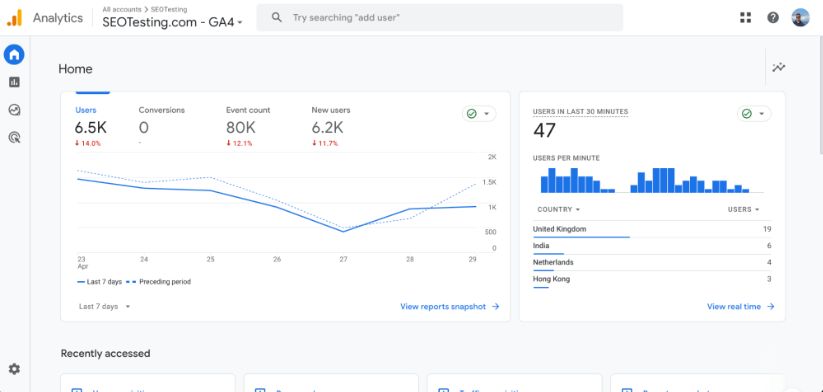
Head to the navigation bar on the left side of your screen. It will open up once you hover over it with your mouse.
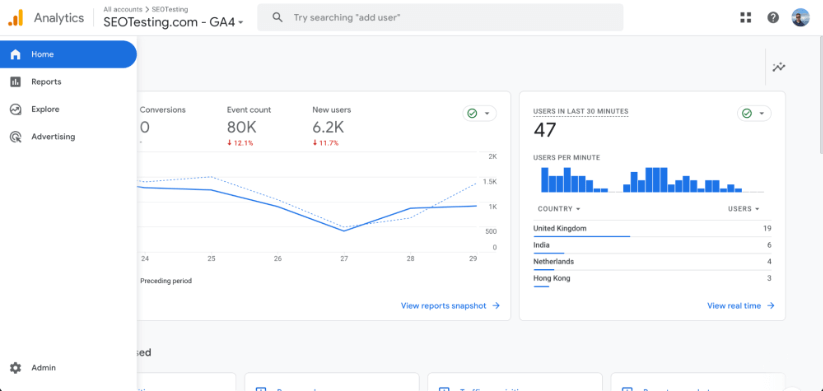
Click on the ‘Reports’ link.
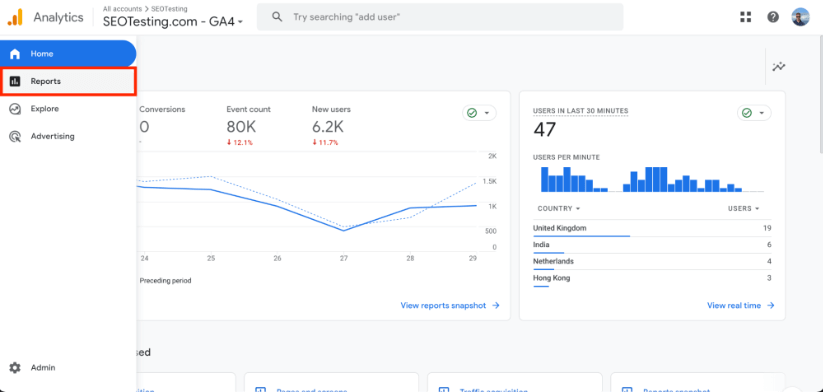
You will be taken to a new screen once you click on the ‘Reports’ link. From here, you have different options on the left side, including viewing different reports. To find our engagement rate metrics, we need to click on ‘Acquisition.’ Specifically, we need to click on the dropdown arrow within the box labeled ‘Acquisition.’
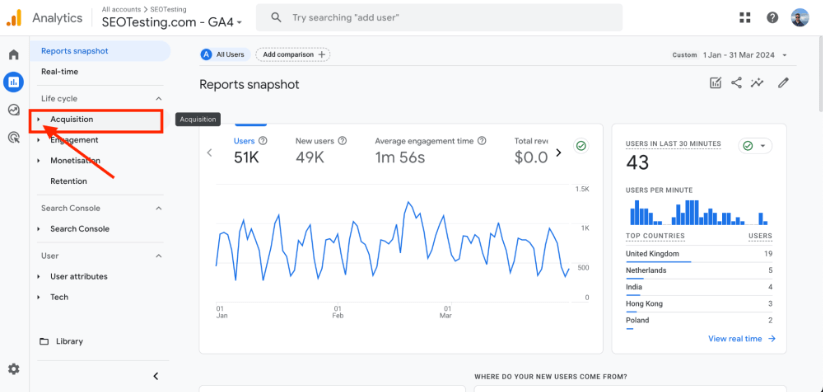
Finally, click on the ‘User Acquisition’ box that pops up.
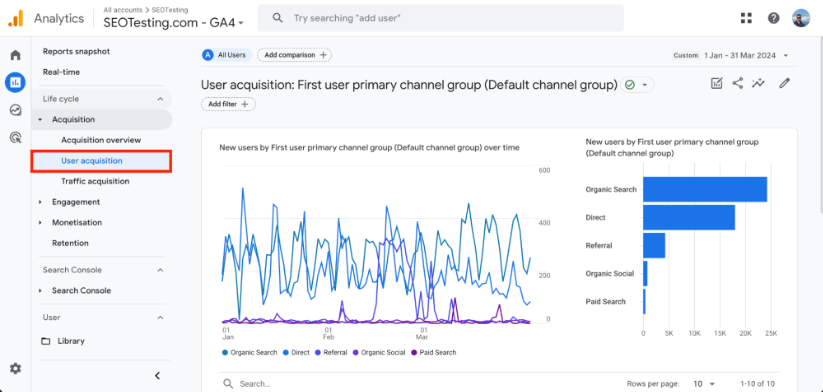
Scroll to the bottom of this report, and you will see a table listing all of your acquisition channels. One column in this box lists the engagement rate for that channel.
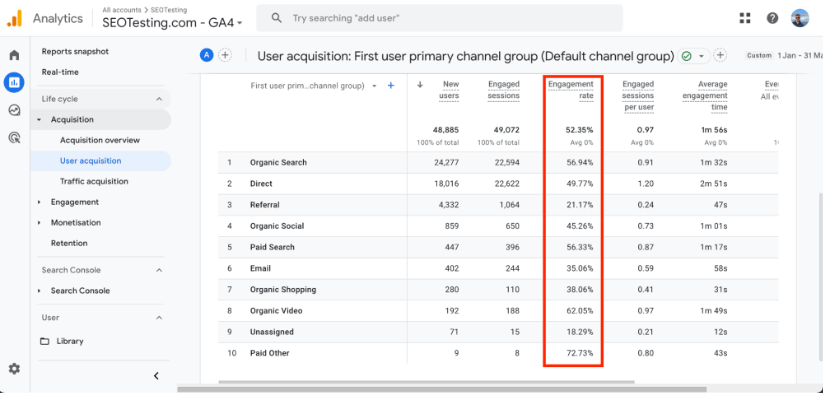
Wrapping Up
Understanding and improving the engagement rate within GA4 is pivotal for anyone managing a website in the digital age. By transitioning from bounce rate to engagement rate, GA4 offers a more nuanced view of user interaction, providing vital insights into how visitors engage with your content.
Numerous strategies exist to boost this metric, whether through the strategic placement of CTAs, diversifying content formats, or enhancing overall website design.
Importantly, engagement rate serves not just as a measure of content performance but also as an indicator of user satisfaction and conversion potential.
Embracing these insights from GA4 can lead to more informed decisions that enhance user experience and contribute to a website’s success.
Ultimately, while there is no one-size-fits-all answer for what constitutes a ‘good’ engagement rate, aiming for continual improvement based on specific benchmarks and goals will guide you toward better engagement and, consequently, better business outcomes.
If you are looking for a tool to test GA4 events along with standard SEO testing, then give SEOTesting a try. Our tool comes with a complete GA4 integration, allowing you to track events (including custom GA4 events) alongside your SEO testing regime. We have a 14-day free trial, and you do not need a credit card to sign up, so give the tool a try today.


